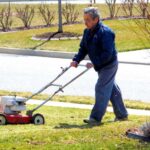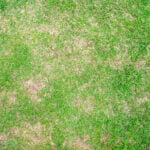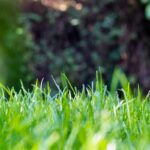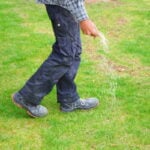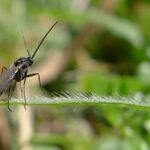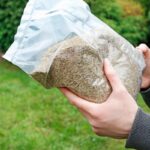A healthy, beautiful lawn offers many benefits besides its looks. It protects against soil erosion, captures and filters stormwater, traps carbon, and muffles street noise. Grass also works as a natural air conditioner and improves mental and physical health.
In this article, we discuss the top benefits of lawns and how turfgrass can help improve your life.
1. Protects Soil from Erosion
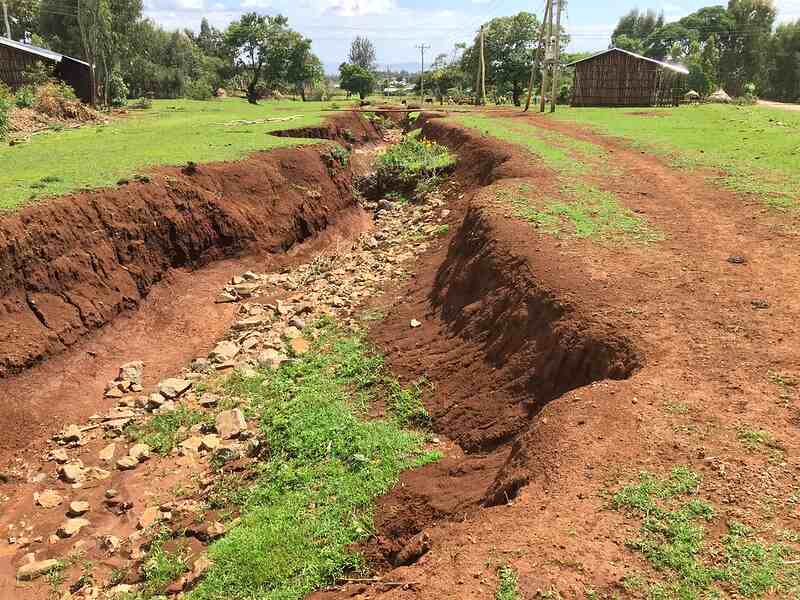
A 1991 study on the effects of a 30-minute rainstorm showed that the sediment lost on turfgrass plots was up to 20 times less than that caused by the same rain on bare soil areas.
With 30 million to over 8 billion shoots per acre, dense turfgrass acts like a buffer, reducing wind speed and water flow on the soil surface. The result is that much less sediment is removed with runoff or blown away as dust particles by air currents.
Underground, healthy grass roots behave like a natural erosion mesh. Turfgrass’ fibrous roots form a dense network with thousands of root hairs that keep the topsoil in place. It’s an ideal ground cover for stabilizing sloped lawns and controlling erosion in sandy yards.
And that’s not all. Turf can also help build and restore damaged soils.
2. Builds and Restores Topsoil
Keeping the ground covered with turfgrass is an excellent way to improve its texture and fertility and build new soil. Natural grass provides shelter and food for millions of microorganisms, which instead convert grass clippings, thatch, and dead roots into new soil rich in organic matter.
Ocean River Institute (ORI), a leading environmental organization based in Massachusetts, uses Somerville – located north of its Cambridge headquarters – as an example of how lawns can contribute to soil building:
“There are nearly 160 acres of green space in Somerville. If our lawns and the soils below were healthy, our lawns could build an inch of soil a year and capture nearly 88,000 tons of carbon dioxide from the atmosphere.”
3. Improves Air Quality
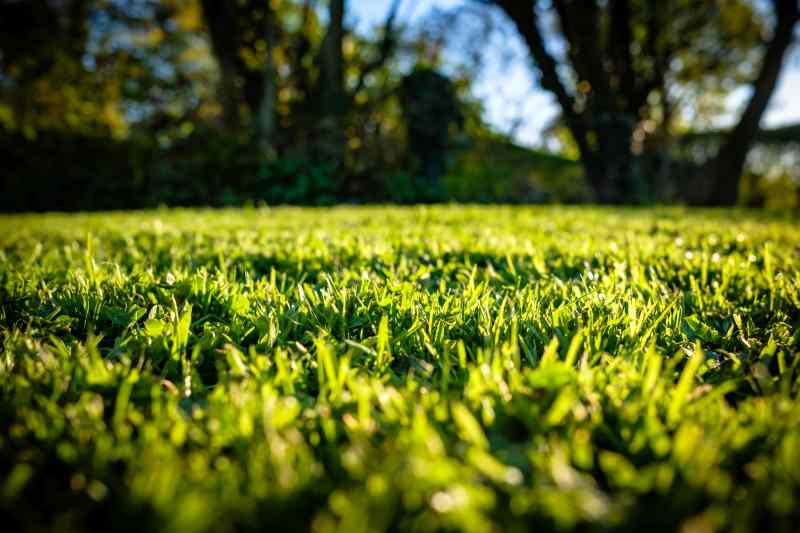
A 2,500-square-foot lawn can produce enough oxygen for a family of four through photosynthesis.
Here’s what happens: Healthy grass absorbs carbon dioxide (CO2) from the atmosphere and water from the soil. It uses sunlight to convert the two ingredients into oxygen and carbohydrates. Oxygen is released into the air, while carbohydrates are used as plant food or stored as carbon in soil and roots. This last stage of storing carbon dioxide in the soil is known as carbon sequestration.
According to the Lawn Institute, natural grass lawns in the United States can sequester between 12.5 million and 95 million tons of atmospheric carbon dioxide per year. That’s equivalent to the annual emissions of 2.4 million to 18 million typical passenger vehicles.
“The better maintained the lawn is, the more carbon is sequestered, even though the inputs of mowing, pesticides, fertilizers, etc., use carbon sources; the net sequestration is 106-122 lbs. more than not having a lawn; the trees are a bonus,” says John Fech, extension educator for the University of Nebraska – Lincoln.
Turfgrass traps more than CO2. It also collects and filters fine particles of dirt, smoke, pollen, and stormwater runoff.
4. Limits Flooding
A 5,000-square-foot lawn can capture between 2,000 and 27,000 gallons of water, says Dr. Kelly Kopp, Professor and Turfgrass and Water Conservation Specialist at Utah State University.
In May 2024, areas north of Houston received 12 to 20 inches of rain in only a few days. The excessive rainwater swamped roads and caused people to be evicted from their homes. Unfortunately, due to climate change, such intense rainstorms are increasing in frequency.
Franco Montalto, a water resource engineer at Drexel University, says the best solution to mitigate increasing urban flooding is to use vegetation areas to capture and filter stormwater instead of relying solely on overwhelmed sewage systems.
This concept is known as the sponge city, and home lawns can play an important role by increasing the green surface that is able to absorb water, not only from rain but also from rapid snow melts. The absorption capacity can be improved by creating swales and installing rain gardens.
Related articles:
- “How to Manage Stormwater Runoff”
- “Tips to Help Lawns Recover From Flood Damage”
- “How Much Does Water Damage Restoration Cost in 2024?”
5. Filters Stormwater
Rainwater filtered through turfgrass is 10 times less acidic than water running off hard surfaces. Grass plants and microorganisms capture and decompose pollutants, preventing them from reaching our waterways.
The EPA says polluted runoff is one of the greatest threats to clean water in the United States. When rainwater from roofs, driveways, and streets flows directly into storm drains, it’s filled with pollutants. Sediments, metals, pesticides, car oil, and bacteria from animal waste get into the closest body of water, contaminating it.
On the other hand, stormwater that lands on grass lawns gets absorbed and filtered by plants and microbial life.
According to Dr. Beard, professor emeritus of Turfgrass Science at Texas A&M University, billions of bacteria exist in each centimeter of the moist litter, grass clippings, and turf thatch. “These organisms offer one of the most active biological systems for the degradation of trapped organic chemicals and pesticides.”
Part of the filtered water stays close to the topsoil, nourishing the grass. Part goes deeper into the ground, recharging the groundwater reserves known as aquifers, which supply 38% of the drinking water in the United States.
6. Cools the Air
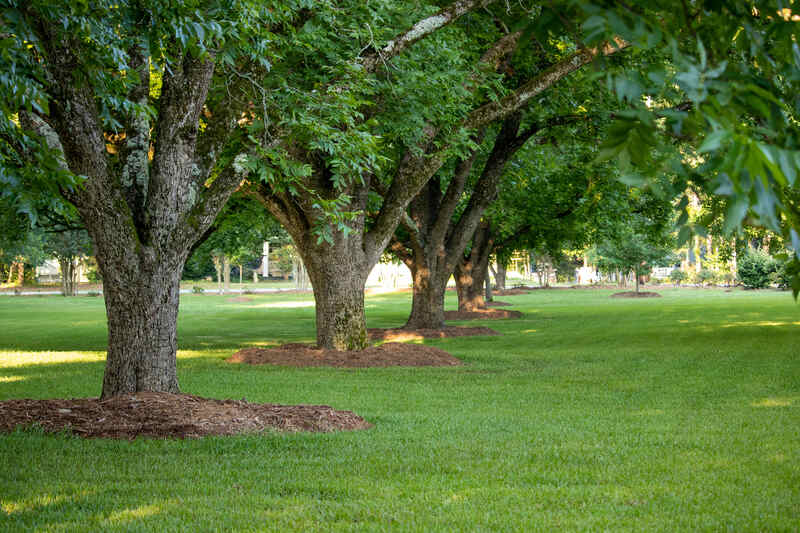
Studies show that healthy lawns are usually 30% cooler than asphalt during a hot summer day and 14% cooler than bare ground.
According to Climate Central, extreme heat is the deadliest natural hazard in the U.S. Urban and suburban areas suffer more than rural areas because of the heat island effect – increased air temperature caused by replacing vegetation with buildings, roads, and other heat-absorbing infrastructure.
How does the cooling effect happen? When it’s too hot, turfgrasses protect themselves by releasing excess water through their leaves, decreasing their temperature and cooling the air around them. The effect is a pleasant decrease in temperature in the surrounding areas, similar to having outdoor air conditioners.
7. Absorbs Noise and Glare
The Handbook for Acoustic Ecology mentions that thick grass may reduce sound levels by more than 9 dB per 100 meters (about 330 feet) at 2000 Hz.
A 10 db reduction in noise is perceived by the human ears as a half decrease in intensity. The noise buffer effect happens because grass and soil absorb the sound instead of reflecting it as hardscapes do. Adding shrubs and conifers can further reduce noise. Learn more from your guide, “How to Use Your Landscaping to Block Out Noise.”
Why is noise pollution a problem? A research review conducted at the College of Engineering in Gujarat, India, indicates that prolonged exposure to noise can lead to health issues such as:
- Hearing loss
- Sleep disruption
- Cardiovascular disease
- Reduced productivity
- Negative social behaviors
Turfgrass also absorbs glare, making outdoor spaces more friendly for human eyes during sunny days.
8. Improves Mental and Physical Health
Green spaces promote physical activity, reduce sedentary behavior, and lower obesity. Even periodically mowing the lawn can make a huge difference for people who are not usually active.
Studies also show that simply touching or walking barefoot on natural grass lowers blood pressure and anxiety.
Natural grass lawns provide a low-cost space for outdoor activities, from socializing at a barbecue with friends to playing baseball or doing yoga exercises. It’s a safe space where kids can learn to appreciate nature and spend time away from their electronic devices. The thick grass carpet reduces the risks of injury from falling during sports activities.
Lawns also connect communities. Unlike backyard gardens, which often have higher fences for privacy, lawns encourage interaction with neighbors and foster a community spirit.
9. Increases Property Value
A healthy, lush lawn improves curb appeal and can increase the home’s value by 10 to 15 percent.
The front lawn is the first thing buyers see when visiting a house. It’s the first impression and can make the house look good or the opposite. Neat, manicured lawns create the perception of a well-maintained property that also extends to the house.
Backyards are also important; they are what visitors see out of the windows in your home and can make the rooms look beautiful and well designed.
Related articles:
- “Lawn and Landscape Projects with the Greatest ROI”
- “Does Lawn Care Affect Your Property Value?”
- “Lawn and Landscape Items That Increase, Decrease Home Value”
Enjoy All the Benefits of a Healthy Lawn!
A healthy, lush, green lawn provides important benefits for homeowners and the natural environment. Find a lawn care professional with LawnStarter and ensure the turfgrass is at its best all year round!
Sources:
- The Lawn Institute (n.d.). Carbon Sequestration. https://www.thelawninstitute.org/environmental-benefits/carbon-sequestration/
- Barry Truax, editor (1999). Handbook for Acoustic Ecology. https://www.sfu.ca/sonic-studio-webdav/handbook/index.html
- Beard, J.B. (1995). The Environmental Protection And Beneficial Contributions Of Golf Course Turf. Texas A&M University. https://archive.lib.msu.edu/tic/mitgc/article/1995119.pdf
- Ocean River Institute (n.d). Lawns with Healthy Soils for Climate Restoration. https://www.oceanriver.org/causes/lawns-with-healthy-soils-for-climate-restoration/
- Fech, J. (n.d.).Benefits of Turf and Mixed Landscapes. https://hles.unl.edu/Benefits-of-Turf
- The Lawn Institute (n.d). Carbon Sequestration. https://www.thelawninstitute.org/environmental-benefits/carbon-sequestration/
- Center for Water Efficient Landscaping CWEL (2023, June). Redefining Lawns: The Benefits and Sustainability of Functional Turfgrasses.[Video] Youtube. https://www.youtube.com/watch?v=vIMxJ3AeyiA
- Montalto, F. (2024, May 14). Sponge Cities Are the Future of Urban Flood Mitigation. https://nextcity.org/urbanist-news/sponge-cities-are-the-future-of-urban-flood-mitigation
- Sithin, M. (2021, January). Role of Turfgrass in Urban Landscapes. https://www.researchgate.net/publication/352211459_Role_of_Turfgrass_in_Urban_Landscapes
- The Nature Conservancy (2023, May 23). Groundwater: Our Most Valuable Hidden Resource. https://www.nature.org/en-us/what-we-do/our-insights/perspectives/groundwater-most-valuable-resource/
Main Photo Credit: Rawpixel
